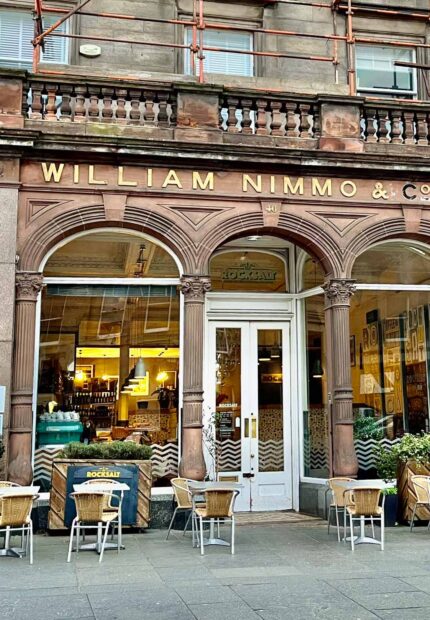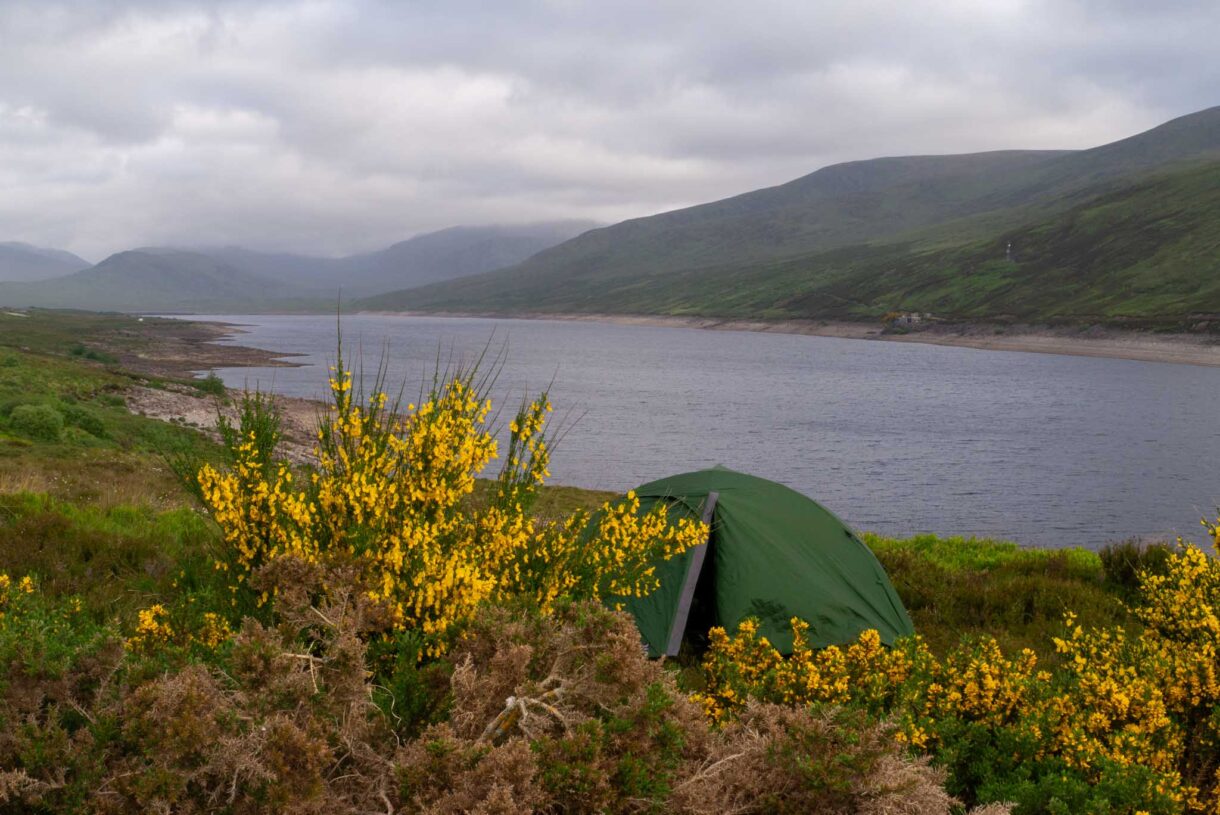
Wild Camping on the Isle of Mull: Know before you go
We’re very lucky to have such incredible outdoor access rights in Scotland. This guide with a map will help you get the most from your visit to the Isle of Mull, as I take you through everything you need to know about wild camping on Mull.
WHY VISIT THE ISLE OF MULL?
The Isle of Mull is a large-ish island on the west coast of Scotland. Nestled in the heart of Scotland’s Inner Hebrides, Mull is a less-touristy but equally beautiful alternative to the popular Isle of Skye.
Many people come to the Isle of Mull to spot wildlife. Eagles, otters, deer, puffins, whales, and dolphins are seen regularly on and around the island. The island’s rugged coastline and prominent mountains in the south are a great place to hike and explore away from the crowds. And the north, with its gorgeous white sandy beaches, almost Caribbean-blue bays, and cute wee towns, cafés, and distilleries, is perfect to unwind.
And for those who truly wish to immerse themselves in nature, there’s no better way than wild camping on the Isle of Mull.
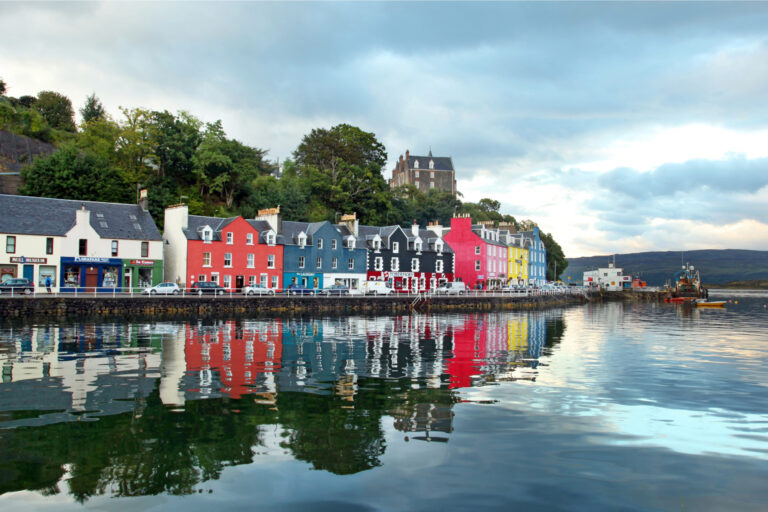
SCOTLAND’S RIGHT TO ROAM LAWS
Wild camping on the Isle of Mull (or anywhere in Scotland for that matter) is such a fantastic experience. This is because of Scotland’s progressive ‘Right to Roam’ laws.
The Scotland Land Reform Act (2003) states that everyone has the right to access most land and inland water for recreational purposes. This means you can hike, cycle, or kayak wherever you like. You can wild camp whenever you find a good spot and sleep under the stars (or the clouds, it is Scotland after all!).
Basically, you can enjoy the outdoors wherever you like, as much as you like. As long as you respect nature, and follow the Scottish Outdoor Access Code.
Note: This is very different to the rest of the United Kingdom. Wild camping is not legal in England, Wales or Northern Ireland. You should always go to a campsite, or seek permission from the landowner before camping in these countries.
Wild camping strips life back to its basics. It’s just you and nature! That’s why we think that wild camping is one of the best ways to experience Scotland.
CAN I WILD CAMP ON MULL IN MY CAMPERVAN/RV?
The right to roam extends to walkers, cyclists, kayak/canoes, and horse riders. If you’re travelling by foot, bike, boat or horse, you can wild camp wherever you like. You’re the true wild campers!
These freedoms do not extend to motor vehicles. You can not park your car or campervan wherever you like.
But you’ll likely need a vehicle to get around and experience all that Scotland has to offer. This makes it more difficult to ‘wild camp’. So, what do you do if you want to get back to nature and sleep under the stars?
Don’t worry! You can still wild camp. Wild camping, done sensibly and respectfully, is fine on Mull. If you have a vehicle, you just have to be a little more mindful and plan ahead. By following the tips below, we’ll help you to get the best out of your trip and suggest some good spots for wild camping on the Isle of Mull.
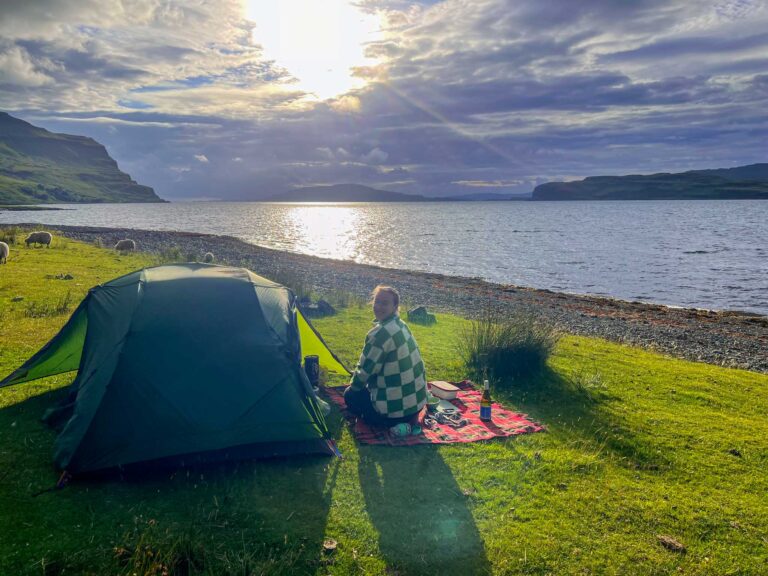
BEST PLACES TO CAMP ON THE ISLE OF MULL
First of all, if you’re travelling without a motor vehicle, you can sleep wherever you like. Just remember to follow the Scottish Outdoors Access Code. Pitch your tent away from settlements or villages, clean up after yourself, and take your litter home.
This section on the best places to camp is aimed at people travelling with a motor vehicle, such as a car or campervan. If you’re driving, you’ll need to do a bit more preparation when thinking about where you want to park up and camp for the evening.
By writing this guide, we’re hoping to help you find a place to park your vehicle safely and legally for the night. We want to make sure you avoid parking in dangerous spots! Especially if it’s late and you’re just ready to park up and sleep.
Check out our handy map below! Red icons indicate good spots we found. Here you can park safely and legally, and there is grass to pitch a tent. Blue icons indicate paid campsites with facilities, in case you’re on the road for a while, and want a hot shower, or a place to empty your waste.
SEMI-WILD PLACES FOR WILD CAMPING ON MULL
Anyone looking to scope out potential spots for wild camping on the Isle of Mull in advance will likely come across the Isle of Mull Tourism website. It’s not very thorough, but does suggest a couple of spots that the council have set up as semi-wild camping spots for people with motor vehicles. These are:
#1 LOCHBUIE
Lochbuie Campsite, in the South of Mull, is a gorgeous spot to camp by the beach. There’s a small gravel-covered parking area where you can park your vehicle without damaging the grass. Lochbuie also has a lovely flat patch of short grass, perfect to pitch your tent if you’re tent-camping.
This is one of our favourite spots for wild camping in Mull. It’s peaceful, and there are only ever a couple of other people camping here. Lochbuie is also home to one of the cutest cafes. The Old Post Office, a farm shop and cafe located in (surprise surprise) an old post office, is a beautiful place to grab a coffee and enjoy the views. The cafe also allows campers to use its 24/7 bathroom facilities, making this a pretty luxurious spot to wild camp on Mull!
The site is maintained by the council. There’s a suggested donation of £5 per night, payable by honesty box, which seems perfectly fair to us!
#2 CALGARY BAY
Calgary Bay is the second council-run site for ‘official’ semi-wild camping on the Isle of Mull. The bay itself is beautiful, with white sand, and crystal clear waters to rival the Mediterranean (although perhaps not quite as warm!). The water is usually calm – perfect for swimming, kayaking and paddle boarding.
There is a small semi-wild camping spot just behind the beach, with places to park your vehicle and pitch a tent. The site has several picnic benches and fire pits, and firewood is sometimes available to buy.
Calgary Bay also has basic toilet facilities. There’s a lovely Art Cafe just up the hill, with a great sculpture trail. It’s free to camp here, but donations are welcome. Overall, we thought Calgary was a beautiful spot, but it can get quite busy. We didn’t camp here, as it wasn’t the ‘back-to-nature’ vibe we were looking for.

UNOFFICIAL SPOTS FOR WILD CAMPING ON MULL
Of course, there are plenty of other unofficial spots where it’s safe to park up for the night. We’ll cover the main rules for wild camping in a minute, but basically, anywhere away from settlements, on a surfaced area (to avoid damaging grass), that isn’t a passing place one a one-lane road, or blocking access to houses or land, is fair game.
Finding your own wild camping spot is part of the joy. We fully encourage you to seek out your own place for the night. But here are our favourite non-council run spots for wild camping on the Isle of Mull! Just in case you need some peace of mind before you start your journey.
We checked out all of these spots, which are drifting around on forums and websites anyway (so they aren’t secret). If you find somewhere else to camp, great! Keep it to yourself, and preserve its special-ness.
#3 CROGGAN
The phrase “off the beaten track” has a very literal meaning in some of the more remote parts of Scotland. If you are looking for somewhere super remote for wild camping on Mull then Croggan is a good option.
Croggan is located on the southeast coast of Mull. It’s a bit of a windy road to get there but well worth it. There’s a small parking lot, just opposite the disused pier, where you can park your vehicle for the night. If you’re tent camping, there are plenty of places on the grass or beach to pitch your tent.
There are no facilities at Croggan. So make sure to clean up after yourself and leave no trace. There are no toilets here, so you might want to check out this guide for where, and how to ‘go’ in the outdoors.
#4 LOCH NA KEAL
There are several great spots to wild camp on the B8035 along the south side of Loch Na Keal. We parked on the gravel at the trailhead for the Ben More hike. There was a lovely flat patch of grass to pitch our tent, and a fresh breeze keeping away those pesky midges!
I’ve bookmarked a couple of places on the map, but we encourage you to scope out your own spot for the night here. If possible, try to respect others’ space. Most wild campers want to feel like it’s just them, and the nature, so don’t park up directly next to another camper if you can avoid it.
Again, no facilities along Loch Na Keal, so make sure to take your trash away and ‘go’ responsibly, and away from any water sources.
#5 DERVAIG VIEWPOINT
The viewpoint over the small village of Dervaig is a great spot for campervans/RV’s to park up for the night. There are no facilities, but it’s just a short walk to the village, which has a small shop, a hotel restaurant, and a pub.
Unfortunately, Dervaig viewpoint isn’t such a great spot for tents. There’s nowhere to pitch, as the surrounding area is completely covered in huge, beautiful ferns!
#6 UISKEN BAY
Uisken Beach is the end of the road, a crofting township with houses dotted around a beautiful sandy bay. It’s very accessible, with a small place to park next to the bay. The crofting community charges a small amount to park here overnight, it’s ~£2, payable at Uisken Croft, just up the hill.
Despite the small charge, this is very much still a wild-camping site, for self-sufficient motorhomes and tents. There are no facilities on-site.
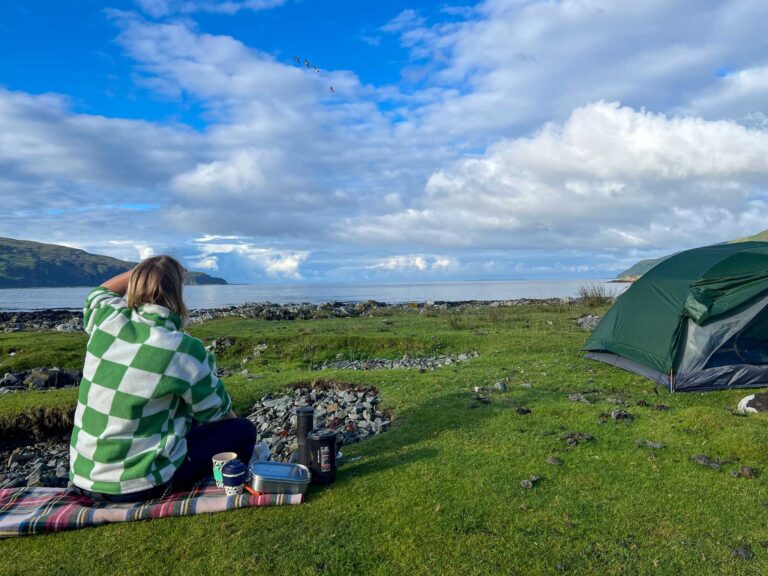
PAID CAMPSITES ON THE ISLE OF MULL
Sometimes, especially on a longer trip, we also want to stop somewhere with toilets and showers. If you’re in a campervan, you might need to empty your waste. It can also be nice to know that there’s definitely a place to aim for if you’re arriving late .Don’t worry. There are tons of official campsites available. It’s not quite wild camping on Mull, but they’ll do!
Scottish Camping is a great place to find official campsites. The website lists the facilities available, and sometimes the prices too. Here are some of our favourites to get you started.
#7 FIDDEN FARM
Less than a mile from Fionnphort Pier (where the ferry to Iona departs) Fidden Farm is a large site next to a beautiful white sandy beach. Open March to September, they offer fairly informal camping, right next to the beach! There are great views over to the isle of Erraid and out to sea. The shallow waters and rock pools are popular with families.
Fidden Farm was our favourite ‘backup option’, in case we couldn’t find anywhere to pitch our tent for the night. They don’t take bookings but there is pretty much always space. Just rock up and pick yourself the best spot as close to the sea as you want to be. The price is £12 pp/pn
Fidden Farm has all the amenities you could need, including toilets, hot showers, drinking water, and chemical waste/grey water disposal. You can also use their freezer, and there are pay-per-use washing machines and dryers. We could think of worse spots to camp, especially if you’ve been on the road for a while!
#8 KILLIECHRONAN CAMPSITE
If you’re looking to enjoy the ‘wild camping’ experience, whilst still having a few facilities, Killichronan Campsite may be for you! Located on the shores of Loch Na Keal, Killichronan is a very basic campsite. There are toilets, hot water, and washing facilities, but no showers or electricity. For the low price of £7 per night, it’s a great option if you can’t find a spot further round, or want to use a proper toilet.
#9 IONA CAMPSITE
Iona, the small island off the southwestern coast of Mull, is gorgeous. With its 1500-year-old abbey, quirky shops, and beautiful beaches, all kept alive by a vibrant small community, Iona is the perfect place to camp for a night.
You can’t bring your vehicle to Iona without special permission. It’s a truly tiny island, with one small road, and most of the residents get around by bike or on foot. This makes Iona tent-only territory (sorry, campervans!). But due to the size and popularity of Iona, the community kindly asks that you don’t wild camp.
Just a short walk from the ferry, Iona Campsite is the only campsite on the island. The campsite is a natural, basic campsite experience with beautiful views. It’s about as close as you can get to ‘wild camping’ whilst still having access to a toilet and shower – there’s also a barbecue area with firepits. The price is £12.50 per tent, which is super reasonable.
#10 TOBERMORY CAMPSITE
Tobermory, in the north of Mull, is the largest town on the island. This quaint town, with its picturesque coloured houses along the seafront, has lots of lovely pubs, restaurants, cafes, and shops. There’s also a whisky distillery. Tobermory is a popular place to base yourself when exploring Mull.
Tobermory Campsite is ~1.5 miles, or ~2 kilometres, from the town – well within walking distance from all those lovely things to do. It’s a large campsite, with all the amenities you’d expect… at a cost of course. Tent camping is an eye-watering £14 per person per night. Campervans start from £32 a night, with additional charges per adult.
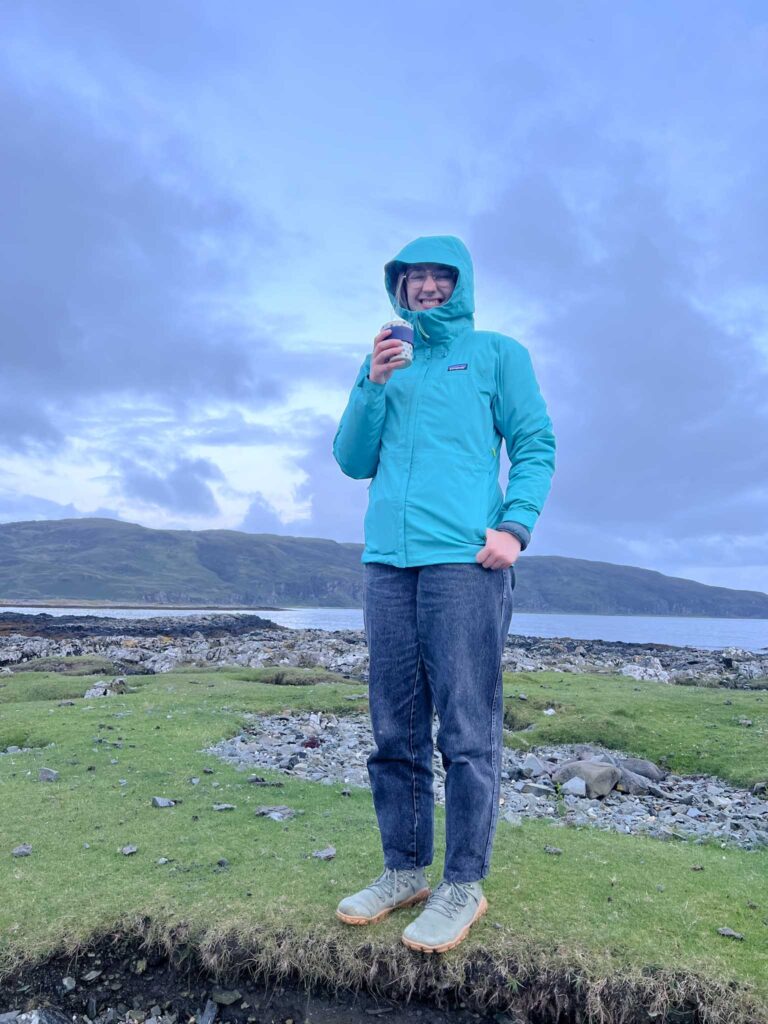
WILD CAMPING DO’S AND DON’TS
We are extremely lucky that wild camping in Scotland is so tolerated. It’s a privilege to be able to camp wherever we like without fear of being told to move on. However, this means that we have a personal responsibility to do our part to take care of the areas we camp in. Here are a few things to keep in mind when wild camping on Mull.
WILD CAMPING DO's...
Arrive late, and leave early: Plan to arrive at your camp spot in the evening, and aim to be packed up and on your way by the time other walkers are up and about.
Leave no trace of your camp: Make sure you take all of your rubbish home with you.
Use a Stove: Instead of lighting open fires, which can damage the ground and pose a fire risk, use a portable stove for cooking.
Camp Away from Water Sources: Set up camp at least 30 meters from rivers and lochs to prevent pollution and protect the water for wildlife.
Think about where to ‘go’. Wild camping often means no toilets. Check out this guide for where, and how to ‘go’ in the outdoors. Remember, if you use toilet paper, you need to take it away with you and dispose of it. Don’t just leave it on the floor!
WILD CAMPING DON'Ts...
Absolutely don’t park in passing places: these may look like parking spots, but they’re essential to allow traffic to pass on the small single-track roads. Not only is it illegal to park or camp in a passing place, but it’s incredibly dangerous! No one wants to reverse for miles, around blind corners, to allow another car to pass…
Don’t camp near settlements. No one wants to wake up to a bunch of random tents in their back garden!
Avoid lighting open fires: campfires are super romantic and fun, but they can damage the ground. In worst-case situations, they might even start a wildfire. If you want to have an open fire, do so in designated places or somewhere you’re sure it won’t get out of hand, like on the beach.
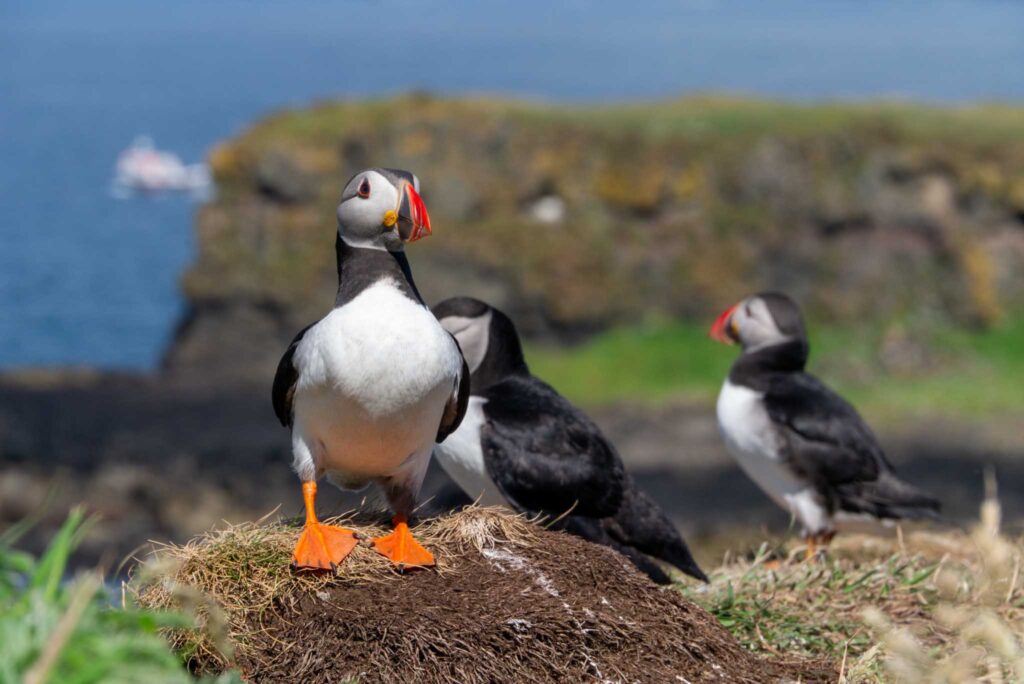
OUR FAVOURITE THINGS TO DO ON THE ISLE OF MULL
1.
Wildlife Watching: Mull is a hotspot for wildlife enthusiasts. Keep an eye out for white-tailed eagles, otters, whales, dolphins, and puffins,
2.
Hiking: The island boasts numerous trails, from coastal paths to mountain hikes. Ben More, Mull’s highest peak, offers a challenging yet rewarding climb. Calgary Sculpture Trail is the perfect shorter walk, with enough to keep things interesting for families (or anyone who likes art!
3.
Beaches: Mull has some of the prettiest beaches in Scotland! White sands and clear waters make the beaches the perfect place to spend a sunny afternoon, especially if you have a kayak or paddleboard. There’s tons of marine life, and some great rockpools to explore too.
4.
Tobermory. The perfect place to spend a rainy day, Tobermory has enough to keep everyone entertained. From lunching in the glasshouse at Isle of Mull Cheese and Spirit to whisky tasting at Tobermory Distillery… Or from wandering around the quirky independent shops, to learning something new at the Hebridean Whale and Dolphin Centre, there’s something for everyone in Tobermory!
5.
Fingals Cave. Fingal’s Cave, accessible from Mull by boat, is a stunning sea cave on the tiny island of Staffa. With striking hexagonal basalt columns (very similar to the more famous Giant’s Causeway in Northern Ireland), the cave forms a visually and acoustically impressive cathedral-like space. It has inspired artists, writers, and musicians for centuries. Who knows? Maybe you’ll be inspired too.
6.
Puffins. Every spring and summer, over 10’000 puffins nest on the island of Lunga. Due to a lack of wild predators here, these charismatic birds are remarkably approachable, allowing visitors to observe them up close. Perfect for photographers, or bird enthusiasts!
That’s it! We hope we’ve given you the confidence for your next Scottish adventure: wild camping on Mull! We’d love to hear all about your experience or add any cool camping spots to the map to help other travellers. Leave a message in the comments below!
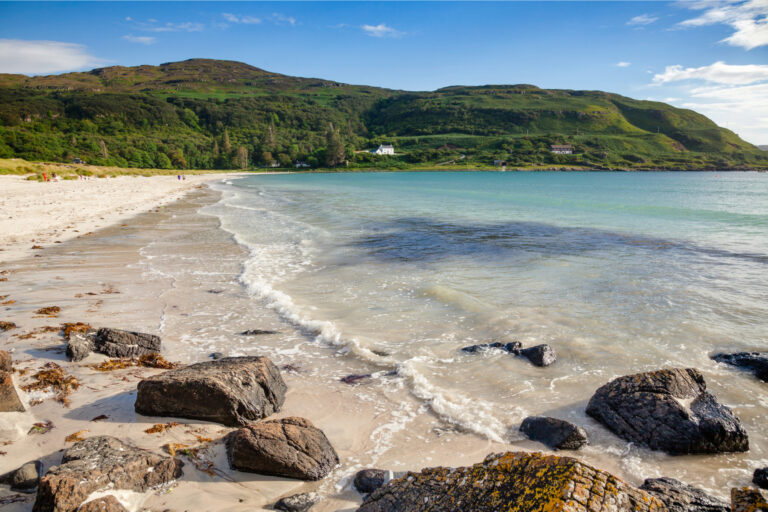
FAQs
Is wild camping on Mull safe?
Absolutely! Mull is a very safe island, and you’re unlikely to run into any issues when wild camping on Mull. The camping community is super friendly. Honestly, the most unsafe part about wild camping on Mull will be ticks, with their itchy bites and risk of Lyme Disease. Use insect repellant and make sure to check yourself after spending any time outdoors in Scotland!
Is wild camping on Mull legal?
Yes, as long as you follow the outdoor access code and don’t disobey any signs you come across.
Can you camp anywhere on the Isle of Mull?
As long as you pick your spot carefully, park your vehicle legally, and follow the outdoor access code – yes!
Can you wild camp in a motorhome on the Isle of Mull?
The outdoor access code does not apply to motor vehicles. But, if you are parking your car in a legal space, where overnight parking is not forbidden (usually a sign will tell you if you can’t park there), you likely won’t run into any issues.
Can you wild camp on Scottish Islands?
Mostly yes, but it depends on the island. Some islands, such as Iona, forbid it. Other islands, such as the Isle of Skye, might allow wild camping itself, but car parks will forbid overnight parking, making it difficult for those with cars and campervans to park up. This is to limit the damage to the environment whilst still allowing ‘genuine’ wild campers – pedestrians – to enjoy the outdoors.
Can I go wild camping on Iona?
No! Iona is small and very popular, and the community kindly ask that you don’t camp wild here. There’s a reasonably priced campsite for tents, which will give you the ‘wild camping’ experience, whilst respecting the wishes of the people who live here. You can’t take your motor vehicle to Iona, so if you want to overnight here, you’ll need a tent!
LIKE IT? PIN IT!
SAVE THIS POST TO YOUR PINTEREST BOARD TO COME BACK LATER
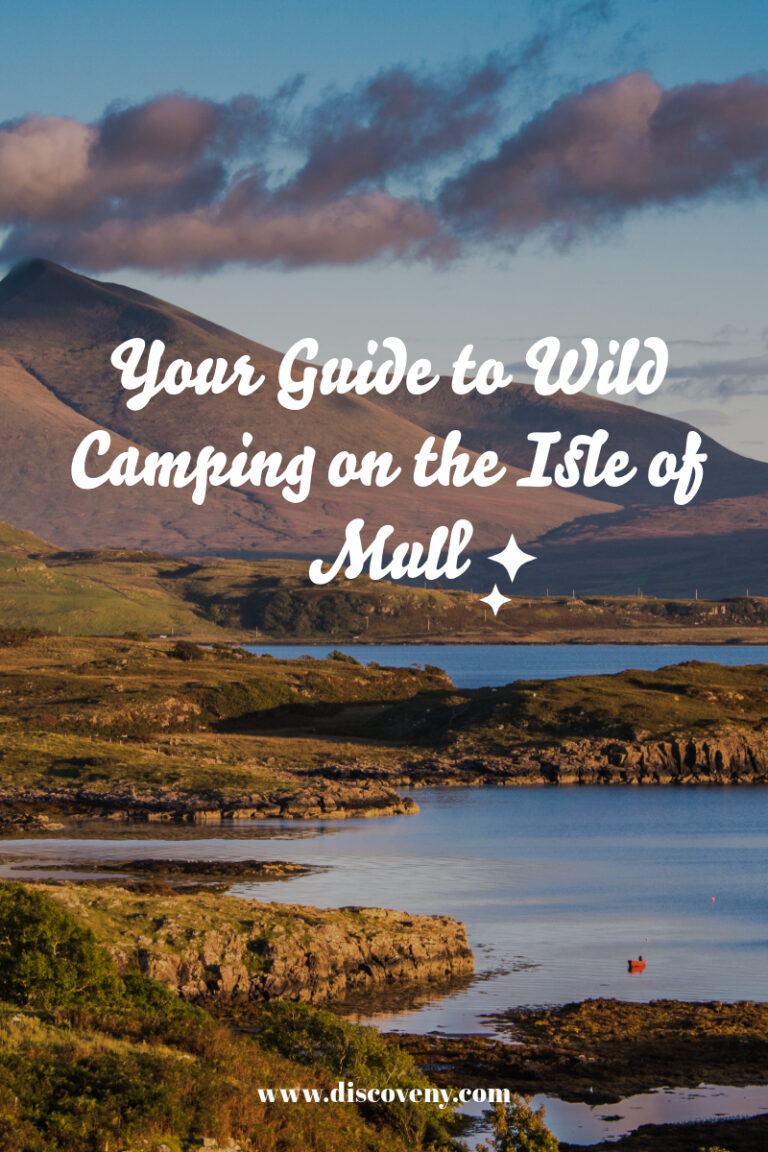

Follow our daily adventures on Facebook and Instagram
Disclaimer: The information and advice provided in this blog are the author’s opinions and based on their personal experiences. All information was accurate at the time of writing. However, things can change quickly, so always double-check current conditions and guidelines before setting out. Remember, your travels and safety are your own responsibility, and this blog can not be held responsible for anything that might happen on your adventures! Always exercise caution and good judgment. Oh, and don’t forget to get travel insurance! Happy travels!
This post may contain affiliate links (yay for transparency!) This means that I will earn a small commission, at no additional cost to you, if you click the link and choose to buy the product. I only link to stuff I have personally bought and found useful and never endorse crap. Your support helps keep the site going, thank you!
Alice
Alice is a UK travel blogger who advocates sustainable travel and being more eco-conscious on a budget. She loves coffee, her houseplants and summiting mountains.
You May Also Like

The Green Guide to Wrocław
November 21, 2020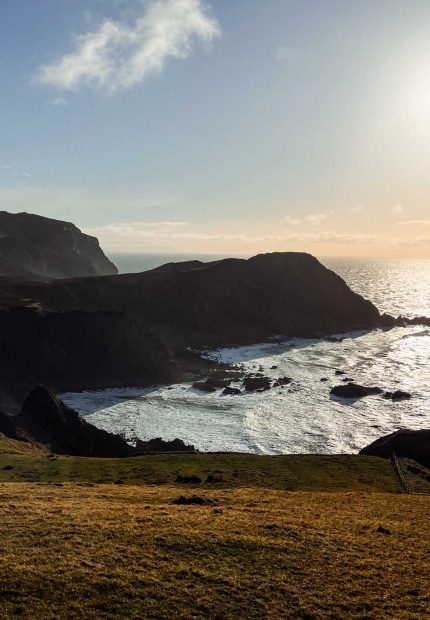
Islay & Jura in Winter: the essential guide
January 27, 2025